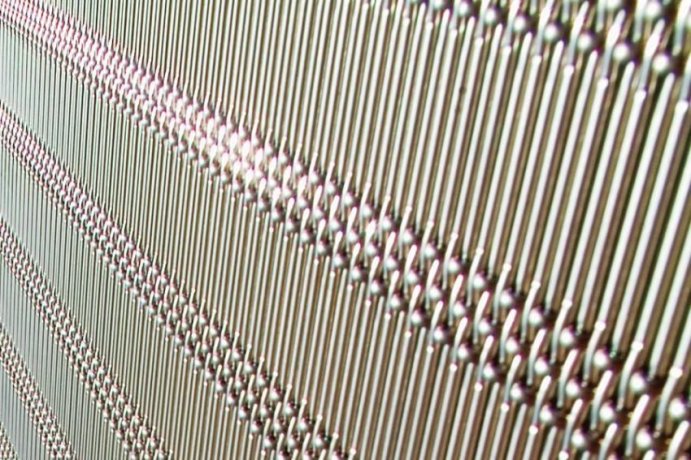Cambridge Architectural Mesh

Pattern Unveiled at New Georgia BioScience Training Center
Cambridge, MD, Oct. 26, 2015 - Expanding on its portfolio of metal mesh patterns that offer architects flexibility in design, Cambridge Architectural has introduced Lanier, a new rigid mesh that provides varying options for open area. The pattern can be used for exterior facades, solar shading and parking garages as well as interior screen walls and partitions.
Lanier is similar to Cambridge's flexible cable/rod pattern Matte but is ideal for rigid in tension solutions. Specified with a standard 50% open area, its open space can be expanded by removing fill wires as the pattern repeats. Lanier can be woven onto tall panels up to 100 feet in height.
"We know that architects are seeking flexibility and looking for mesh choices that create a more stimulating visual appearance while providing options for varying degrees of light passage, " said Cambridge National Sales Manager David Zeitlin. "In the case of Lanier, they can even choose to expand the openness of the pattern for a single panel. We call this option Transition."
Made in the U.S., Lanier is named for Lake Lanier in Georgia, where it was first introduced at the Georgia BioScience Training Center, which opened in September 2015. The new landmark workforce development and research facility for the State of Georgia was designed by Cooper Carry in Atlanta.
The majority of the facility's exterior façade is clad with Lanier: 149 individual panels covering 10, 900 square feet. The mesh provides a dynamic aesthetic as well solar shading from the Georgia sun for the Center's interior lobbies, classrooms and laboratories. The pattern was also used for solar shading and visual screening surrounding the Center's elliptical courtyard and main conference room.
Lanier can be attached using Cambridge's standard Eclipse, Eyebolt and U-binding attachment methods or with a Clevis intension system and flatbar design, as was used for the Georgia BioScience project.







